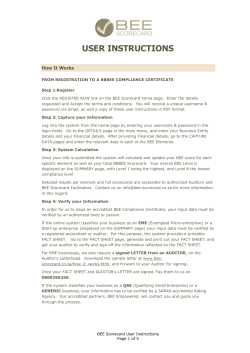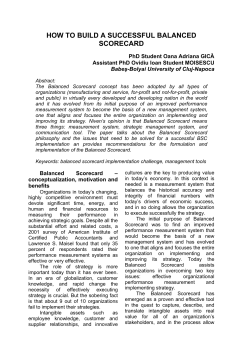
How to Credit Score with Predictive Analytics WHITEPAPER
WHITEPAPER How to Credit Score with Predictive Analytics Managing Credit Risk Credit scoring and automated rule-based decisioning are the most important tools used by financial services and credit lending organizations for credit lifecycle management. They are commonly used in consumer lending for products such as credit cards, personal unsecured loans, lines of credit and residential mortgages. The benefits of using credit scoring tools, techniques and methodologies include: More objective frameworks for credit risk evaluation while eliminating biases Lower transaction costs and time lags associated with decisions to extend credit to consumers and businesses Improved optimization of individual credit decisions and overall portfolio performance More accurate analysis, assessment and benchmarking of credit portfolios over time External or generic credit scores and scorecards built using traditional statistical methods have commonly been used to improve the management of consumer lending portfolios. The challenges associated with successfully deploying and using these non-proprietary credit scoring and decisioning systems include: High cost and time associated with developing and maintaining a robust credit scoring and adjudication system Limitations on the ability of credit scoring systems to identify individual, differentiated lending decisions with a high degree of precision and confidence Best practices in the financial services industry for consumer lending, notably in the areas of credit card and personal unsecured financial products, have moved toward the use of proprietary credit scores and strategies created using data mining and predictive analytics. These allow financial services organizations to augment and extend generic scores and scorecard based systems in order to make more differentiated decisions at the individual borrower level. Predictive analytics capabilities and the ability to act upon their insights and best actions throughout the credit decisioning lifecycle is recognized as a strategic competitive advantage resulting in improved profitability and market share growth—particular for customer acquisition and retention strategies. Risk Management The increased usage of data mining and predictive analytics capabilities as an integral component of credit lifecycle management is driven by market and regulatory forces. Market drivers include, among others, industry consolidation among traditional retail banking and consumer lending businesses. Regulatory drivers include increased scrutiny of the credit granting process with the advent of the Basel Accords and other reforms in market regulations. Financial services lenders are mandated to establish greater transparency, while assuming higher levels of accountability for their increased reliance on automated credit decisioning systems to address risk in retail portfolios. 2 At the same time, lending organizations are challenged to produce continuous improvements in their automated credit origination systems that maximize profitability while mitigating credit losses and minimizing operational cost. In accordance with the Basel Accords, credit risk management has been extended through the entire lifecycle of financial products. Acceptance or rejection of applications is now only the beginning of a series of decisions to be evaluated, assessed and applied to each new account. For instance, to reduce selection biases in credit applications decisions and ensure the relevance of scorecards to the total applicant population, reject inference methods are used to infer the behavior of rejected applicants. After new customers are accepted, a series of additional models are applied to new accounts such as behavioral, retention or delinquency models. Data mining and predictive modeling improves your ability to proactively manage and optimize risk and reward alternatives. Each stage of the customer credit lifecycle can be assessed and optimized by incorporating analytics directly into your strategies: Acquisition and Retention Accept or reject candidates for financial products or credit related services Pre-qualify marketing campaigns on a product to avoid targeting prospects that would decline the offer Optimize interest rate/premium value/credit amount i.e. requesting a higher deposit for a mortgage or charging higher interest rate on a loan Decide on down payments Apply customer retention strategies only to low risk customers (segment strategies) Account Management Decline/accept line increases Allow customers to go over credit limits or past due dates Decide to reissue credit cards Offer better pricing Collections Improve collections and recovery strategies Separate the “good bads” from the “bad bads” so that collections resources can be appropriately focused at the appropriate stages Direct delinquent accounts to best collection strategy: mailing, call center, legal, doorstep Optimize predictive dialer lists Suggest the next best action for an account with real-time integrated models 3 Proprietary Scorecards Credit risk scorecards remain the most common framework used for credit risk lifecycle decisioning due to their simplicity and pragmatic approach. Use of external providers to create scorecards remains popular because scorecard development can be a long, tedious process. Often only a few resources within the organization’s risk team are capable of performing this type of advanced analysis. Moreover, once a scorecard has been developed, risk managers have to consume the results and apply the relevant key performance indicators (such as marketing and financial policies) in order to define strategies and develop a set of recommended actions to be deployed. The need for more complex risk assessments at each phase of the credit lifecycle, and for a broader range of available financial products, has made it necessary and more effective for organizations to develop and deploy their own proprietary risk scorecard capabilities with the use of predictive modeling. Risk scorecards are the standard approach to assess, monitor and communicate risk levels within organizations. The capabilities of scorecards are almost uniformly based on simple logistic regression models. However, the key attribute of a scorecard is how the model results are delivered. A customer score is a sum of points based on their individual profile. An individual can be assigned a score by determining the points related to their characteristics and by summing the values obtained across the characteristics contained in the scorecard: Figure 1: An example of a scorecard developed in Angoss KnowledgeSTUDIO In the example in figure 1, having an Average Monthly Balance below $50 adds 177 points; owning a home (Residential Status=’Own Home’) adds 87 points; and living in a region coded “Nine” adds 85 points to the individual’s overall score. 4 This scorecard format, where each individual characteristic is mapped into a set of points, offers a number of key advantages including: Ease of interpretation and monitoring by decision makers who may not have knowledge of statistics Clear explanations for low scores to easily explain and communicate with decision stakeholders Risk scorecards can be combined with other information such as profitability and expected approval rate, and they can be integrated into a comprehensive scorecard used to define business strategies that will maximize revenue and mitigate bad debt. KnowledgeSTUDIO® KnowledgeSTUDIO provides analysts with the ability to create high quality, proprietary credit scorecards as a seamless step in the analytics workflow. KnowledgeSTUDIO aids in each stage from data profiling and segmentation to predictive modeling and scorecard building, through to strategy design, execution and portfolio analysis and reporting. KnowledgeSTUDIO puts the power of scorecard creation in the hands of internal staff to create predictive scorecards that span the entire risk management lifecycle – from acquisition through to collections. The scorecard tool in KnowledgeSTUDIO automates every step of the scorecard development and deployment process to provide: Comprehensive data profiling and partitioning Optimal binning using Weight of Evidence for coarse classing of variables Logistic regression models Reject Inference techniques for credit application scoring Model analysis and validation tools Scorecard scaling SAS and SQL code generation Direct deployment capabilities The scorecard tool employs a recognized scorecard workflow approach to develop and deploy credit risk scorecards. Figure 2: Coarse classing of variables using Optimal Binning and Weight of Evidence 5 KnowledgeSTUDIO allows you to develop and deploy credit risk scorecards based on the following processes: Data exploration and segmentation Correlation matrix to eliminate variables that should not be included Data partitioning into training and validation sets Variable analysis to assess predictive power and perform coarse-classing using Weight of Evidence Multivariate analysis and modeling—build stepwise logistic regression models Modeling with Reject Inference techniques to infer the behavior of rejected applicants Model validation—evaluate model performance and choose the best model Model scaling—scale model probabilities into desired scorecard, and determine baseline and the scorecard factor Produce management reports on final scorecard Scorecard deployment translates scorecard models into code to be deployed into enterprise data warehouse and operational systems Figure 3: Modelling and validation stage—logistic regression output in KnowledgeSTUDIO Conclusions KnowledgeSTUDIO helps financial services and credit lending organizations better assess, manage and monitor credit risk throughout the credit risk lifecycle by providing a comprehensive platform to develop and monitor credit risk models, scores and strategies—and deploy them as proprietary scorecards to support improved credit risk decisioning. KnowledgeSTUDIO users experience accelerated credit scoring processes, improved automation and monitoring of results, and benefit from its intuitive user interface and visualization—making predictive analytics accessible and easy to use for statistician and credit risk analysts. 6 About Angoss Software As a global leader in predictive analytics, Angoss helps businesses increase sales and profitability, and reduce risk. Angoss helps businesses discover valuable insight and intelligence from their data while providing clear and detailed recommendations on the best and most profitable opportunities to pursue to improve sales, marketing and risk performance. Our suite of desktop, client-server and big data analytics software products and Cloud solutions make predictive analytics accessible and easy to use for technical and business users. Many of the world's leading organizations, including 9 of the top 15 global banks, use Angoss software products and solutions to grow revenue, increase sales productivity and improve marketing effectiveness while reducing risk and cost. Corporate Headquarters European Headquarters 111 George Street, Suite 200 Toronto, Ontario M5A 2N4 Canada Tel: 416-593-1122 Fax: 416-593-5077 Surrey Technology Centre 40 Occam Road The Surrey Research Park Guildford, Surrey GU2 7YG Tel: +44 (0) 1483-685-770 © Copyright 2012. Angoss Software Corporation – www.angoss.com 7
© Copyright 2025





















